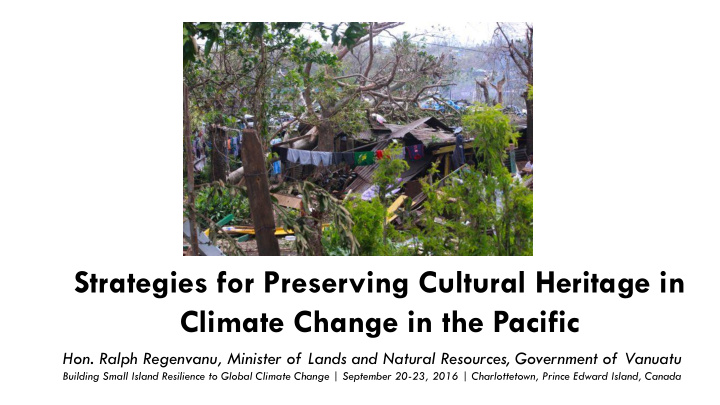



Strategies for Preserving Cultural Heritage in Climate Change in the Pacific Hon. Ralph Regenvanu, Minister of Lands and Natural Resources, Government of Vanuatu Building Small Island Resilience to Global Climate Change | September 20-23, 2016 | Charlottetown, Prince Edward Island, Canada
MELANESIA
REPUBLIC OF VANUATU
DEFN: INTANGIBLE CULTURAL HERITAGE For the purposes of this Convention, 1. The “intangible cultural heritage” means the practices, representations, expressions, knowledge, skills – as well as the instruments, objects, artefacts and cultural spaces associated therewith – that communities, groups and, in some cases, individuals recognize as part of their cultural heritage. This intangible cultural heritage, transmitted from generation to generation, is constantly recreated by communities and groups in response to their environment, their interaction with nature and their history, and provides them with a sense of identity and continuity, thus promoting respect for cultural diversity and human creativity. For the purposes of this Convention, consideration will be given solely to such intangible cultural heritage as is compatible with existing international human rights instruments, as well as with the requirements of mutual respect among communities, groups and individuals, and of sustainable development. Article 2(1), Convention for the Safeguarding of the Intangible Cultural Heritage
DEFN: INTANGIBLE CULTURAL HERITAGE (CONT.) For the purposes of this Convention, 2. The “intangible cultural heritage”, as defined in paragraph 1 above, is manifested inter alia in the following domains: (a) oral traditions and expressions, including language as a vehicle of the intangible cultural heritage; (b) performing arts; (c) social practices, rituals and festive events; (d) knowledge and practices concerning nature and the universe; (e) traditional craftsmanship. 3. “Safeguarding” means measures aimed at ensuring the viability of the intangible cultural heritage, including the identification, documentation, research, preservation, protection, promotion, enhancement, transmission, particularly through formal and non-formal education, as well as the revitalization of the various aspects of such heritage. Article 2(2 & 3), Convention for the Safeguarding of the Intangible Cultural Heritage
SUBJECTIVE WELL-BEING 2016 HPI : #4 Global Ranking #1 Regional Ranking
MELANESIAN WELL-BEING INDICATORS: MEASURING WHAT MATTERS TO THE SOUTH PACIFIC
Natural Resource Access Customary Lands Forest Resources Marine Resources ALTERNATIVE DOMAINS OF • Natural Resource Access • Traditional Knowledge & Practice WELL-BEING FOR MELANESIA • Community Vitality
Traditional Knowledge & Knowledge: Language, History, Environment, Song, Dance, Art Practice Practice: Production Skills, Traditional Wealth Access, Ceremonial Participation ALTERNATIVE DOMAINS OF • Natural Resource Access • Traditional Knowledge & Practice WELL-BEING FOR MELANESIA • Community Vitality
Community Vitality Two-thirds of ni-Vanuatu gave a fully positive Traditional assessment of their traditional leaders in 2012 in Governance terms of communication, respect for culture, ability to maintain peace, and management of community resources. 83% of ni-Vanuatu provided assistance Safety, Equality, to others in their community towards child care, construction, farming, tending livestock and more in Support the last 12 months. 38% perceive a level of equality with others in their community. Respect for family and leaders, hard work, giving back to Values others and helping those in need are all important values to over 80% of ni-Vanuatu. ALTERNATIVE DOMAINS OF • Natural Resource Access • Traditional Knowledge & Practice WELL-BEING FOR MELANESIA • Community Vitality
Recommend
More recommend